
Yoga in Physical Education
Yoga is also a sport in Physical Education. Nowadays, Yoga has become very popular throughout the world. The present age can be said the age of stress, tension and anxiety. So, most of the persons have not been living a happy and fruitful life. In western countries, Yoga has become a way of life. It has a vital significance in the life of human beings.
Explore about Yoga and its different Kinds
- What are the advantages of Yoga?
- Rules for Yoga Practice in Hindi
- Class 11 Physical Education
- Class 12 Physical Education
The history of Yoga is indeed ancient. Nothing can be said firmly about the origin of Yoga. Only it can be noted that Yoga originated in India. The available evidence shows that the history of Yoga is related to Indus valley civilization. At that time, people used to do Yoga based on a secondary source. It can allude that Yoga originated approximately 3000 BC in India. Patanjali wrote the first book on Yoga in 147 BC. Yoga is derived from a Sanskrit word ‘”Yoj’ which means union or join.
- 1. According to Patanjali, yoga means to control the desires of a human being.
- 2. The system of yoga is built on the three main structures: exercise, breathing and meditation.
- 3. The practices of yoga are designed to put pressure on the glandular systems of the body, increase its efficiency and total health. The body is looked upon as the primary instrument that enables us to work, and so a yoga student treats it with great care and respect.
- 4. Breathing techniques are based on the concept that breath is the source of life in the body. The yoga student gently increases breath control to improve health.
- 5. The two systems of exercise and breathing prepare the body and mind for meditation, and the student finds a straightforward approach to a quiet mind that allows silence and healing from day-to-day stress.
- 6. Regular daily practice of all three parts of this structure of yoga produces a clear, bright mind and a healthy, capable body and mind.
The eight steps or elements of classical yoga are:
Asanas are the first and the most important stage of yoga. They are specific body postures practised to keep the body healthy. Asanas help in exercising every muscle, nerve and gland of the body and are thus highly useful in maintaining physical fitness. Mentioned below are the Sanskrit names (along with the English name) of the major asanas.
Some of the asanas are discussed below:
Padmasana means lotus posture. This asana gives the appearance of a lotus. It is the best asana for contemplation.
- Sit on the ground by spreading the legs forward.
- Place the right foot on the left thigh and the left foot on the right thigh.
- Place the hands on the knee joints as shown in the figure.
- Keep the body,back and head hand erect.
- Eyes should be closed.
- It helps in improving concentration and memory.
- It helps to preserve vital fluids in the body.
- It prevents abdominal disease and female disorders.
- It brings peace and longevity
On performing this asana sensation is felt in the body.We should do the movement in relaxed manner. Inhale slowly and exhale slowly. While drawing the abdominal region inwards and expanding the chest, focus the attention on breathing.
1. With knees, ankles and big toes touching the ground, take a kneeling position. 2. One should sit on the heels and place palms on the knees as shown in the figure. 3. Draw the abdominal region inside and expand the chest.
1. The blood pressure patients will benefit from this asana. 2. It also strengthens the spine.
Also known as sun salutation, the Surya Namaskar is one of the best exercises that one can perform.The benefits accruing from these exercises are unique and excellent. The Surya Namaskar is performed usually early in the morning facing the morning rising sun. It is done in 12 steps, each step having its own posture with its own breathing pattern.
- 1. Stand erect facing the sun with palms folded and both the thumbs touching the chest. Breathing: Inhale while raising the hands and exhale as hands are brought down.
- 2. Raise hands upward, with feet firmly on the ground and bend backwards and stretch arms Breathing: Inhale
- 3. Slowly bend forward,hands touching the earth,head touching the knees. Breathing:Exhale
- 4. Set both hands with palms down firmly on the ground, pull the left leg backward, raise the head looking the sun. Breathing: Inhale.
- 5. Bring right leg back close to left leg keeping hands and leg straight.Bend the body at the hip forming an arch. Breathing:Exhale.
- 6. Stretch yourself fully on the ground in the saashtanga Namaskar pose. Feet, knees,thighs, chest and forehead touch the ground with the hands stretched out. Now slowly turn the head to the sides first to left and then to right. Breathing inhale first and then exhale fully.
- 7. Slowly raise the head bend backward as much as possible, hands straight. Breathing Inhale.
- 8. Parvatasana – same as step 5. Breathing: exhale.
- 9. Same as step 4 with the difference that the right leg is brought forward Breathing: inhale
- 10. Same as step 3 – Breathing: exhale
- 11. Same as step 2 – breathing: inhale
- 12. Same as step 1- Breathing, exhale: inhale and exhale.
1. Surya Namaskar improves the physical body prana (breathing) mind, intellect and the bliss components of the entire human personality. It can be used as a personality development tool. 2. It also reduces the extra fat from your body. 3. It improves body posture. 4. It strengthens the body muscles.
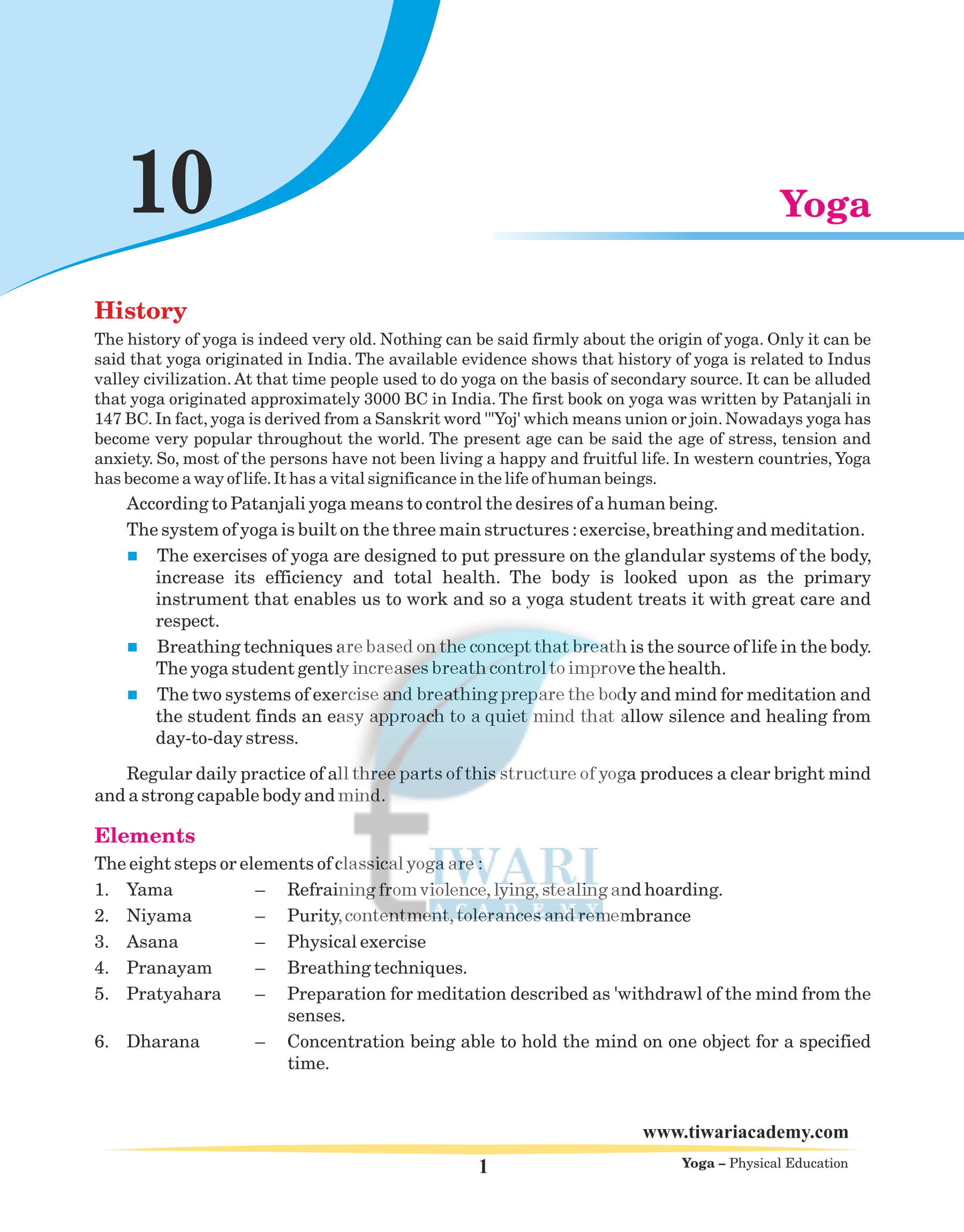
Copyright 2024 by Tiwari Academy | A step towards Free Education


The leader in quality Physical Education, Athletics, and Fitness equipment for 75 years.

Yoga in PE: Tips for Activity Progressions & Lesson Planning

Incorporating yoga in my physical education curriculum has enhanced my ability to teach students about flexibility, stress management, and mindfulness. It is an excellent addition to any program, and students really enjoy it. Yoga is a great lifetime activity that can help students learn to deal with stress, improve their mood, and increase fitness levels which helps them lead healthier, happier lives. When I first started teaching yoga, I was unsure of how to plan the unit activity progressions and format lessons. Here are some of my favorite resources to get you started!
Yoga Unit Activity Progression:
- Teacher-led yoga activities
- Circuit yoga activities
- Student-led yoga activities
- Partner yoga activities
- Technology-led yoga activities
Teacher-led Yoga Activities:
I feel students participate better when a teacher is modeling and leading yoga activities to start the unit. Take classes at a local gym to get more comfortable and try yoga app workouts to learn more about cues, breathing techniques, safety considerations, and a flow of poses.
- Use a variety of yoga resources such as yoga cards, circuit cards , exercises from yoga posters , and Yoga Spots to help you lead several mini sessions.
- Break up the sessions into themes and styles of poses: Floor, Balance, Twist, Bends, Strength, Lying Down, Back Bends, and Standing.
- Teach a Sun Salutation series and other flow workouts. I used an example from the article Harvesting Harmony: Mindfulness in Physical Education , by Shannon C. Mulhearn, Pamela Hodges Kulinna, and Kent A. Lorenz inthe Journal of Physical Education, Recreation & Dance (July, 2017). It’s straightforward and something students can memorize to use every day.

Circuit or Station Yoga Activities:
- Single pose stations : Determine the number of stations needed (2 to 4 students per station) and print a single yoga pose on a sign, use a poster, or a Yoga Dotz floor spot . 1 pose per station for at least 60 seconds. This allows time to read the cues and try it out, especially for poses that use both sides of the body.
- Multi-pose station circuit : I place multiple yoga poses at a station by rainbow color theme. Blue cone and blue cards = balance poses. Red = twisting. Orange = floor poses, etc. I disperse students among the cones (whether a circle or straight-line formatted circuit) and they work together to try out these poses for approximately 5-7 minutes before rotating to a new cone station.
- Rainbow UltraFit CircuitPro Yoga Pack : I love how I can use this versatile pack for any of the suggested yoga activities, and it comes with an excellent teacher’s guide. Rotate student groups through the different circuit cards. Each card has a good 3-step breakdown of how to properly perform the pose. The Rainbow color coding is a huge bonus because it helps with creating teams, management, and grouping and allows for integrating nutrition themes.

Student-led Yoga Activities
- Team Presentations: In small groups of 2 to 4 (depending on how many presentations you have time to allow for), each student selects (or draws from a selection) at least 2 poses to learn and teach. The team decides what order to teach them in. Teams practice their workout, including how to cue the pose – emphasizing proper breathing and technique. Create a rubric for the presentation so students understand your expectations. Teams then take turns presenting to the class. You can have students peer review presentations as well.
- Small Group Workouts: Using the same idea as the team presentations above, instead of presenting to the entire class, the small groups can lead their mini-yoga sessions concurrently all throughout the classroom. As the teacher, you can roam around and visit the sessions and supervise.
- Student Leaders: When students are in a group at a station with multiple poses, they each take turns teaching exercises. This format provides more student ownership. For example, during the Rainbow Yoga Circuit mentioned above, I have students take turns leading the poses. One person leads, the rest follow. Rotate to next leader and so on until it is time to move to a new station.
Partner-based Yoga Activities

I enjoy using the partner poses from the Yoga Pretzels cards. These are simple, low-risk partner balance poses. These are fun for students to try, provide a different nuance to flexibility training, and provide a positive way for students to interact and connect with each other. Students can work with the same partner each pose or rotate to a new partner each pose. I demonstrate each pose with a student and then have the students try them.
Technology-based Yoga Activities:
Two favorite app resources are Yoga Studio and Balance It. Use Yoga Studio to expose students to a yoga class format and flow of poses. It also demonstrates what a good app is like for yoga training.
The Balance It app by the PE Geek, Jarrod Robinson, has balances of two, three, four, and large group poses for group challenges. These emphasize teamwork, trust, strength, flexibility and fun. I have used this app with my family on vacations with the little kids for a challenge activity. We all laugh and have a good time trying to create the poses. It is fun for the whole family or for your classroom!

Yoga Lesson Outline Example (*30-minutes):
- ‘Walk & Talk’ with partner/neighbors around space. Groups of 2 to 3.
- Topics ideas: stress management, relaxation, flexibility, FITT principle.
- Debrief and sharing about walk & talk to set the scene.
- Go over today’s Learning Targets and link to walk and talk.
- Overview of today’s yoga session and mindfulness emphasis.
- Challenge, connect and engage students
- Mini-activity, Game or Personal Challenge
- Yoga workout with theme (flexibility, balance, flow, sun salutation, strength, combination)
- Flexibility, Balance & Core Training
- Project-based: Design-your-own workout, student presentations, etc.
- Debrief learning targets (think-pair-share, partner talk)
- Personal goal setting and home application
- Infuse mindfulness practices and provide students some relaxation time. Gopher’s Mindfulness Banners are a great start to teach mindful sitting, breathing, listening, and how to do a calming body scan.

For more on tips and resources on how to incorporate yoga into your physical education program, check out some other Gopher blogs:
- Yoga in PE: Teaching Tips to Get Started
- Mindfulness and Yoga in Physical Education
- Teaching Yoga in Middle School
Continue the conversation… What are your favorite yoga tips and resources? Share with the PhysEd family in the comment box below or on Twitter! @JessicaShawley @GopherSport #physed #yoga #mindfulness
Leave a Reply Cancel reply
Your email address will not be published. Required fields are marked *

The leader in quality Physical Education, Athletics, and Fitness equipment.
Featured Resources
5 ways small sided games make a big impact, author: jessica shawley, a brand new tool for pe you didn’t know you needed, author: brett fuller, 5 skill-based floor hockey games, author: michael beringer, 16 parachute team building activities, author: tim mueller, we're social, motivating unmotivated students, author: dr. robert pangrazi, jessica shawley, and tim mueller, promoting activity and success through adapted pe, author: dr. robert pangrazi, marci pope and maria corte, author: randy spring.

JOIN OUR NEWSLETTER
Sign up to receive the latest physical education resources, activities, and more from educational professionals like you straight to your inbox!

- Pete Charrette
How to Incorporate Yoga Into Physical Education: 20 Poses and Postures to Use in a PE Class
Adding yoga to physical education is an excellent way for students to learn about and experience the various benefits of yoga and mindfulness. Yoga movements and poses can help students learn about their bodies and understand how to move with proper alignment and posture, as well as improve strength, flexibility and balance. It also has the added benefit of helping students focus and concentrate on the task at hand, allowing them to stay engaged in the class. Additionally, yoga can help to reduce stress and anxiety levels in students, making them better able to deal with challenging situations both in and out of the classroom.

Pics by Bo Phillips @Bo Phillips10 and Mrs. Hochman (& Mr. Ramlow) @CopelandD70PE
This blog post will explore the benefits of providing yoga classes in a physical education program and provide guidance on how to successfully integrate it into your curriculum. I will also highlight 20 yoga poses that can be implemented in class lesson to help students practice their mindfulness skills while having fun. These yoga poses are perfect for students of all levels, whether they're beginners or experienced yogis. They work well as part of a warm-up routine, cooldown session or focused lesson.

Pic by Bo Phillips @Bo Phillips10
What are the benefits of implementing yoga in PE?
1. Yoga Improves Muscle Strength, Flexibility and Balance – Yoga helps to build strength, flexibility and balance in all students, regardless of their physical abilities. It is not only a great form of exercise, but the health benefits are outstanding.
2. Yoga Helps to Develop Focus and Concentration – Practicing yoga in class can help students to focus better on their tasks, as well as increase their overall concentration levels. It is great for helping them in their academic pursuits.

3. Yoga Enhances Stress Relief – Overall, students who participate in a yoga class report lower levels of stress and anxiety, allowing them to stay engaged and focused during the school day. Not only can Yoga serve as a means of relaxation, but it can also act as aerobic exercise by raising students' heart rates for a specific amount of time.
4. Yoga Increases Body Awareness – Yoga poses and movements can help students become more mindful of their bodies, teaching them how to move with proper alignment and working on any area they may have trouble with.
5. Yoga Provides Opportunities for Group Interaction – Yoga is a great way for students to interact with each other as well as with the teacher, fostering team building skills.
Will incorporating yoga classes in physical education help cover standards?
Not only is learning yoga beneficial for students, but it also helps to cover important standards. By focusing on building strength, flexibility and balance with yoga poses, teachers can be sure that they are incorporating all of the necessary components into their lesson plans. The yoga movements and poses highlighted in this blog article directly match-up with SHAPE America Standard 2 which states: The physically literate individual applies knowledge of concepts, principles, strategies and tactics related to movement and performance .*

How can I incorporate yoga into a PE lesson?
Now that you know some of the reasons why incorporating Yoga into physical education is beneficial, let’s look at some tips for successfully implementing it:
Start out slowly - Don’t expect students to be experts at yoga right away! You are not teaching power yoga or yin yoga right away! Provide simple poses and step-by-step instructions so that they can learn gradually through regular yoga practice. Explain how each pose can help improve physical fitness, mental focus and relaxation.
Incorporate Yoga into warm-up and cool-down activities - Focus on poses that improve flexibility through physical activity, such as Child's Pose, Mountain Pose, Downward Dog, or an Upward Dog Stretch.
Consider different levels - Not all students will be comfortable with the same poses. Consider providing options for different levels of difficulty so that everyone can participate at their own level. The key to teaching yoga is working with the students in front of you.

Set a positive atmosphere - Make sure to create an environment where students feel safe and supported while trying yoga poses. Allow the students to move freely through each pose. Use yoga mats if possible. Provide guidance only if they show difficulty with a certain pose. Make it fun!
Teach proper breathing techniques - This will help the students learn to relax their bodies and mind during yoga practice. Encourage the students to practice mindfulness through deep breathing exercises. Have them focus on their breath, how the pose feels, and how it benefits their body.
Give feedback - Offer supportive feedback and corrections as needed so that students can learn proper technique and form. In addition, foster a sense of connection and support between classmates by encouraging them to help each other out. If you want to be even more helpful, get guidance from a certified yoga teacher to help you with your lessons.
20 Yoga Movements and Poses for Physical Education Classes
Yoga is an excellent way to supplement physical education activities and create a more holistic approach to learning. Below are 20 yoga postures that can be used in a PE class yoga workout.
Assign these yoga activities to your students as solo tasks, or have them work in pairs or small groups where they take turns teaching each other (on a yoga mat if possible) at designated stations around the learning area. The activity can also be done by the entire class as one large yoga session with a teacher leading the instructions.
1- Basic Poses (Level 1)
Child' Pose- Sit back on your heels and roll your midsection forward. Bring your forehead to rest on the ground in front of you. Stretch downward and extend your arms in front.

Mountain Pose- Stand tall with your feet together. Keep your shoulders relaxed and raise your hands over your head with your palms facing each other. Reach up high.
Upward Dog - Place your hands on the floor alongside your body. Keep your elbows in close and press down through your hands. Straighten your arms and lift your torso slightly off the floor.
Easy Pose- Sit and cross your legs in front of you. place each foot beneath the opposite knee. Fold your legs in toward your torso and place your hands on your knees.
Downward Dog- Start on all fours and walk your hands a few inches forward. Curl your toes under and slowly press your hips up toward the ceiling. Bring your body up into an inverted V.

2- Basic Poses (Level 2)
Bridge - Lie on the floor with your knees bent directly over your heels. Press your feet into the floor as you lift your hips up off the floor. Push your arms downward.

Triangle Pose- Extend your arms out to your sides and bend over your left leg. Move your left hand towards the floor and extend your fingertips of your right up to the ceiling.
Cobra Pose- Lying facedown on the floor, tighten your core and push your hips downward.
Press your shoulders down and raise your chest toward the wall in front of you.
Warrior Pose- With your legs apart, turn your left foot out 90 degrees and your right foot in slightly. Extend your arms out to the sides and bend your right knee to 90 degrees.
Head to Knee; Forward Bend- Sit down and bring the sole of your right foot to the inside of your left thigh. Hinge forward from your hips and fold over your left leg. Extend your arms forward.

3- Intermediate Poses (Level 3)
Boat Pose - From a sitting position, lean back and slowly raise your legs up and off the ground. Stretch your arms out towards your feet and hold the position.

Salutation Seal- Sit comfortably with your legs crossed in front of you. Bring your palms together and press your hands firmly against each other. Keep your chin in close to your body.
Tree Pose- Shift your weight onto your right leg and place the sole of your left foot inside your right thigh. Bring your hands in front of you in a prayer position with your palms together.
Seated Twist- Cross your left foot over the outside of your right thigh and bend your right knee. Place your right elbow outside your left knee and your left hand on the floor. Twist your body.
Low Lunge- Take a giant step forward and bend your front knee to 90 degrees. Keep your front shin upright to the floor and place your arms straight up over your head.

4- Advanced Poses (Level 4)
Cow Face Pose - Sit down and bring your right leg underneath your left leg. Reach your right arm down your upper back and cross your left arm around and up from your lower back. Hold the pose.

Crow Pose- Press your palms to the floor and walk your feet forward until your knees touch your arms. Bend your elbows and lift your heels up and off the floor. Toes stay on the floor.
Pigeon Pose- Bring your left knee between your hands and place your left ankle near your right wrist. Extend your right leg behind you and balance your weight evenly.
Lotus Pose- Sit down and bend your right knee toward your body. Lift your left ankle up and across to the crease of your right hip. Cross your right ankle over the top of your left shin.
Bharadvaja's Twist- From a sitting position, shift your weight to your left side, then bend your knees and bring your legs to the right. Twist and hold your upper torso to the left.

Final thoughts
Yoga is a great way to incorporate physical exercise and mental relaxation into physical education. It can help students build strength, flexibility, balance, coordination and focus while engaging in mindful breathing practices. Implementing yoga poses can also be a fun way to provide variety to PE classes. To begin incorporating yoga into PE classes, it is important to start with basic poses (Level 1) and gradually progress to more difficult poses (Level 4). It is also important to provide detailed instructions on pose alignment, teachings on breathwork, and offer modifications as needed. I have provided a list of 20 Yoga poses and movements that can be used in PE classes. With these simple tips and poses, you can easily incorporate yoga into your PE classes to benefit your students both physically and mentally.
Thank you for reading this blog post on implementing yoga into physical education! These tips and movements hopefully give you a starting point for your own PE classes. Namaste Yoga teachers!
*SHAPE America. (2013). National Standards for K-12 Physical Education. Reston, VA: Author.
Need resources?
Do you need some PE Yoga Movement Challenge Cards that can easily help you teach poses and postures like the ones discussed in the yoga in PE article above? Would it help to have easy-to-implement visuals that include detailed instructions and state-of-the-art graphics? Cap'n Pete's Power PE has you covered!

Fill in the form below to download 12 FREE fun and active PE Movement Challenge Cards with a variety of yoga poses and postures to teach in your physical education classes.
The set is a PDF digital download that includes twelve visuals (cards) that teachers can use for teaching Mindfulness through YOGA Poses. The cards make it EASY for physical educators to help guide students through a variety of engaging YOGA movements and they provide opportunities for them to develop their flexibility, muscular strength, and endurance.
This freebie set will be sure to enhance your PE curriculum for years!
If you REALLY want to expand your physical education program's arsenal, check out Cap'n Pete's, 6 Resource Yoga in PE Super Bundle . Inside this packet you will find a variety of YOGA instructional materials and visuals that can be used by physical education teachers, classroom teachers, coaches, fitness instructors, camp counselors, and any other leaders of movement-based activity.

You can download them from either of the following platforms: Cap'n Pete's Power PE Website or Teachers Pay Teachers- Cap'n Pete's TPT Store
The Super Bundle consists of 6 of Cap’n Pete’s YOGA-Related products that include:
1. YOGA Instructional Cards- "Kid Friendly" Cues and Visual Illustrations
2. Fidget Spinner PE Spin Boards- 9 YOGA, Balance and Flexibility Spin Boards
3. Fitness Adventure Series- Mindfulness Mission
4. PE Spin & Move- Yoga Edition
5. PE Distance Learning Series- 24 Yoga Poses for Home
6. Yoga Poses- Top 10 Movement Visuals

- Creative Movement
- Stations and Circuits
- Fitness Activities
Related Posts
18 Top PE Activities for Dynamic Physical Education Classes
Run, Walk, Thrive: How to Implement a Mileage Club at Your School
Energizing Education: The Power of Brain Breaks in the Classroom; Includes 12 Practical Activities
Recent Posts

Understanding the New SHAPE America Physical Education Standards for 2024

Mastering the Dynamics of PE Classroom Management: A Comprehensive Guide

6 Best PE Games to Transform Your Physical Education Classes

Empowering Your Voice: A Comprehensive Guide to Physical Education Advocacy

Engaging At-Home PE Activities for Effective Distance Learning in Physical Education

Adopt-a-Gym: Enhancing Physical Education for Underfunded Schools

The Top PE Equipment Providers for 2024: A Comprehensive Guide for Physical Educators

15 Fun PE Stations for Active Engagement in Elementary Physical Education Classes

Harnessing the Power of AI in Physical Education: Enhancing Efficiency and Effectiveness

Developing Positive Character Traits in PE: The Heart of Physical Education

What is Physical Education? A Comprehensive Overview for Educators

The Top 20 PE Blogs: Essential Reads for Every Physical Education Teacher

Asanas: Meaning, Definition and Purpose
Anyone who’s taken a yoga class has probably heard the term “asana.” Asanas are the physical body positions or poses of yoga that form the foundation of a modern hatha yoga practice. While most classes only teach the basics, there is a wide range of difficulty and complexity of the yoga asanas. To fully understand and learn the asanas, we will need to uncover the history of them, their origin, and how they’re used today in yoga. Gaining this knowledge opens up the doors for us to have a deep, profound and insightful practice.
Asana meaning and definition in Yoga
Asana is a Sanskrit word meaning “posture,” “seat,” or “place.” Asanas are the physical positions we assume during a hatha yoga practice. Each pose has its own Sanskrit and English name. Almost all of the Sanskrit names for the poses end with “asana.” For example, the classic lotus pose is named Padmasana, and the common tree poses is named Vrikshasana. Many of the asana names have come from the shapes and movements of animals and elements of the natural world. Some names differ by different schools of yoga , and some of the names have changed over time. There are several asanas that have been known by multiple names at different time periods.
There are many different types of poses , but they all follow the same basic principles of alignment and muscular engagement. They include everything from simple twists and backbends to advanced balancing poses . There can be many variations on the individual poses, and each variation has its own benefits, purpose and challenges.
An asana can be performed as a still and static position that can be held for several breaths, or it can be a posture that is part of a dynamic flowing movement that lasts for less than one inhale or exhale. The period of time it is held is dependent on the school of yoga followed and the intensity and difficulty of the physical posture. For example, Iyengar Yoga emphasizes yoga anatomy and physical alignment so the poses are held a while. In contrast, Ashtanga Yoga and Vinyasa styles move quickly between poses linking movements with breath as in the sun salutations.
While there is no wrong way to do any asana, there are a general principles of alignment, breathing techniques, and mindfulness that should be followed to prevent injury and maximize the benefits of yoga .
How many yoga postures are there?
Patanjali’s Yoga Sutras was one of the first yogic texts to mention the word asana. Patanjali includes it as one of the eight limbs of yoga and in sutra 2.47 he notes that asana should be “steady and comfortable.” The classic Hatha Yoga Pradipika text describes 18 postures but goes on to state that “Shiva taught 84 asanas.” Yet a later text called The Gheranda Samhita notes that “there are 8,400,000 asanas described by Shiva. The postures are as many in number as there are numbers of species of living creatures in this universe. Among them 84 are the best; and among these 84, 32 have been found useful for humankind in this world.” Most yoga teachers only lead about 15-25 poses in their classes. YogaBasics’ pose directory has 120 of the main modern asanas listed with photos and step-by-step instructions.
The history of the asanas
The original asanas were simple seated positions designed to be performed by yogis during meditation . They were steady yet comfortable shapes designed to focus the mind and calm the nerves and allow one to enter a deep meditative state.
Since those early days, more and more asanas were created for different reasons. In the 11th century at the Goraksha Sataka text was the first to describe a non-seated asanas. The Hatha Yoga Pradipika was written in the 15th century and describes 18 poses, but none of these are standing poses . Non- seated poses first appear in the Gheranda Samhita which was composed in the 17th century.
In the famous 1966 asana book Light on Yoga , B. K. S. Iyengar included the asanas his teacher Krishnamacharya created from a fusion of traditional Indian wrestling, gymnastics, and British Army calisthenics. In 1974 yoga instructor Sri Dharma Mittra created an “Ultimate Yoga Chart” poster that contained a list of 908 asanas which was later published as a book .
The difference between asanas and other physical exercise
The practice of yoga combines stretching, breathing, mindfulness and meditation to improve your health, reduce stress and increase strength and flexibility. It’s less of a workout and more of an exploration into the mind-body connection. It’s a holistic lifestyle that is a mental and spiritual journey rather than a physical challenge.
In contrast, gymnastics and other physical exercise focus on building muscle mass, endurance and stamina through quick repetitions or sets of movement. There is no emphasis on breath work, mindfulness or developing the mind-body connection. Yoga is not a competitive sport like running or weight lifting. It is designed to develop balance, coordination and concentration through controlled movement while embracing non-judgement, kindness and compassion for yourself and others.
Asanas purpose and benefits
The modern practice of asana focuses primarily on its health benefits, and is used as a low-impact form of exercise. The traditional goals of asana also included preventing disease and promoting a healthy body but focused more on its spiritual purpose and benefits. By learning to control and discipline the body, the body’s energy and mind are also calmed and focused. Below are the more traditional and perhaps unknown purposes of a regular asana practice:
- Yoga asanas are practiced to increase inner strength and focus to create a strong container to withstand the intensity of tapas , the austerity practices used to reach a state of enlightenment.
- Yoga postures are used to control, purify and cultivate prana , the life-force energy the flows through the nadis or energy channels of the body.
- Asana practice creates mental, emotional and energetic balance. When you perform asanas regularly, it helps reduce negative thought patterns and regulate the emotions .
- Asanas are one of several yogic practices used to reduce bad karma and prevent its accumulation.
- A grounded and steady physical practice facilitates the deeper practices of pranayama, bandha, and mudra. These hatha yoga practices help direct and calm the energy and promote further exploration of the subtle body.
- A strong asana practice enables one to explore the conscious and unconscious mind through the layers of the koshas and subtle body. This allows one to gain insight into the true nature of self and reality.
The relevancy of asana in the yoga tradition
Asanas are a relatively small aspect of yoga when compared to the overall depth and breath of the tradition of yoga. They are a relatively small slice of an older and much larger body of knowledge, philosophy, lineage, and techniques. For example, you can explore other aspects of yoga such as breathing exercises , meditation, codes of social conduct, self-observances, diet, devotion, or selfless service, without having to do any asanas at all.
The ultimate goal of yoga is the union of one’s individual mind, body, and spirit. Yoga poses are one method you can help you attain peace within yourself by practicing self-discipline and self-awareness. Asanas were not intended to be a standalone practice. Instead, they were meant to complement the other practices of yoga .

Finding the Best Time to Meditate: Tips and Advice on When to Sit

Purusharthas: The Four Goals of Life

Trimurti: The Hindu Trinity of Brahma Vishnu Shiva

Brahman: Definition, Meaning, and Philosophy

Yoga Nidra: Meaning, Benefits, Videos and Tips

17 Rules for Living Like a Yogi

The Best 16 Heart Opening Yoga Poses

18 Clear Signs of Negative Energy in a Person
Remove Ads with a
Premium Membership
Explore More
Yoga tips advice articles practices basics techniques.

Which Yoga Class Is Best for Beginners?

7 Essential Skin Care Tips Every Yogi Should Know

8 Tips to Maintain a Daily Yoga Routine at Home

15 Tips for Creating an Amazing Home Yoga Studio


How Yoga Helps To Ease Suffering

12 Morning Yoga Tips to Start and Sustain Your Practice

Practicing Yoga on Carpet: Pros, Cons and Top Tips

The Importance of a Daily Yoga Practice

4 Powerful Ways to Cultivate Self-Compassion in Yoga
4 responses to “asanas: meaning, definition and purpose”.
As a long-time yoga practitioner, I found this article to be a helpful reminder of the basic principles of asanas. It’s important to always go back to the fundamentals
I am curious to know more about the history and origin of these asanas. Are they all from ancient India, or have they been developed over time by different cultures?
I had no idea there were so many variations of yoga asanas!
Ultimately, the goal of yoga is to find that union within ourselves. Asanas are just one tool to help us on that journey of self-discipline and self-awareness.
Leave a Reply Cancel reply
Your email address will not be published. Required fields are marked *
Save my name, email, and website in this browser for the next time I comment.
- Weight Loss
- Mental Health
- Relationships
- Find a solution for...
- Meditation – Overview
- Happiness Program
- Happiness Program for Youth
- Sahaj Samadhi Dhyana Yoga
- Online Meditation and Breath Workshop
- Advanced Meditation Program
- Dynamism for Self & Nation (DSN)
- Blessings Program
- Sudarshan Kriya Follow-Ups
- Volunteer Training Program
- Teacher Training Program
- Children and Teens – Overview
- Utkarsha Yoga
- Medha Yoga Level 1
- Medha Yoga Level 2
- Intuition Process
- Know Your Child Workshop
- Know Your Teen Workshop
- Corporate Programs
- Workshop to Get Rid of Anxiety & Sleep Disorder
- The Art Of Living Programs For Schools
- Sri Sri Sanskar Kendra
- Yoga – Overview
- Sri Sri Yoga Classes (Level 1)
- Sri Sri Yoga Deep Dive (Level 2)
- Yoga Teacher Training
- Sri Sri Yoga Retreats
- SpineCare Yoga and Posture Program
- The Art of Living Programs for Schools
- Karma Yoga (YLTP)
- Wisdom – Overview
- Events – Overview
- World Culture Festival
- Maha Shivratri
- International Women’s Conference
- World Forum for Ethics in Business
- Global Leadership Forum
- Guinness World Records Events
- Social Impact – Overview
- Rural Development
- Organic Farming
- Environment care
- Women Empowerment
- Disaster Relief
- Prison Program
- Water Conservation
- River Symposium
- Social Impact
- The Art of Living
- About Gurudev
- Sudarshan Kriya
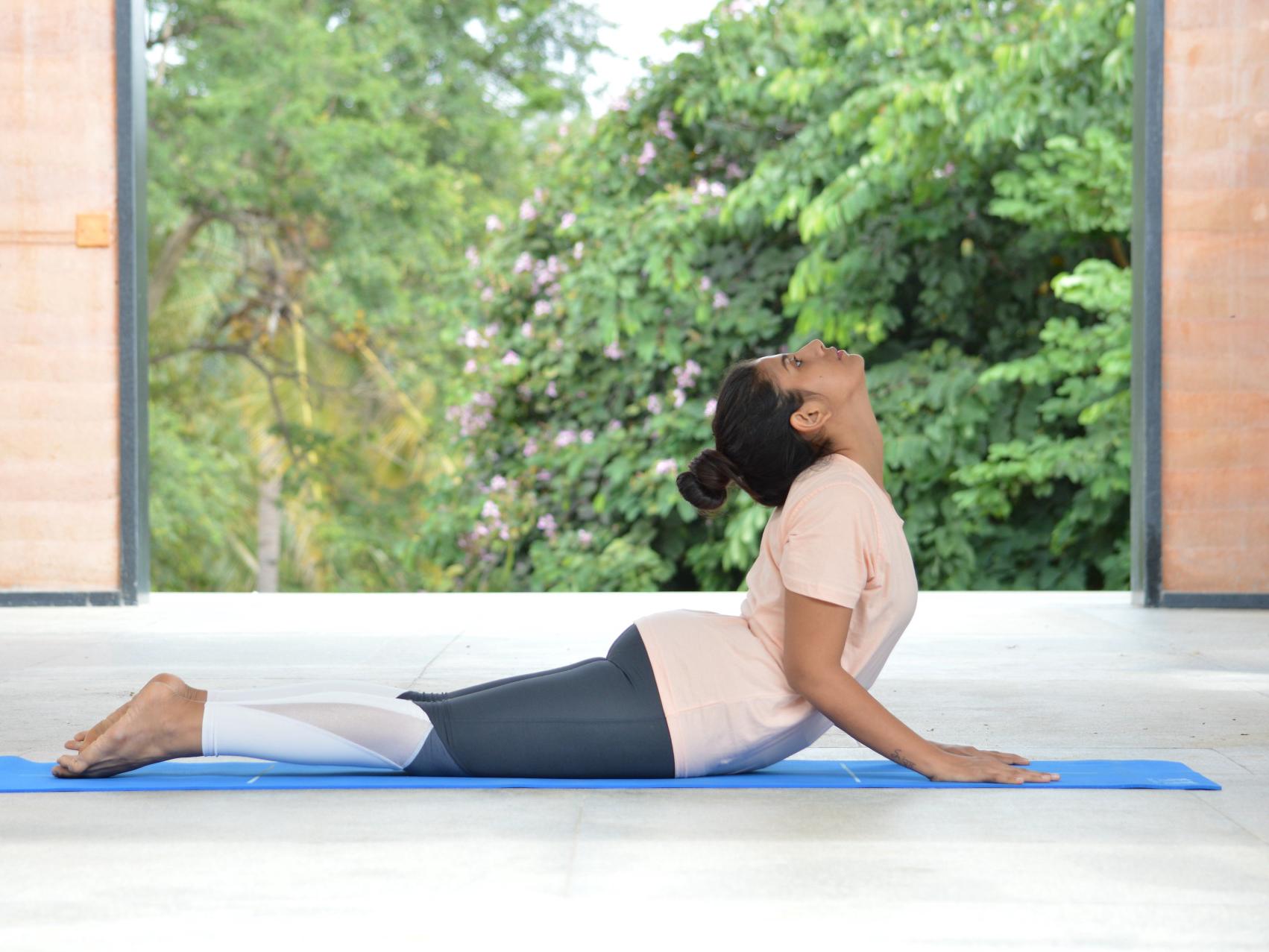
Bhujangasana (Cobra pose)
What is bhujangasana.
Bhujangasana is pronounced as Bhu-jung-aahs-uh-nuh.
Bhujangasana (Cobra Stretch) comes from the word bhujanga meaning cobra or snake and asana meaning pose. Bhujangasana is also known as Cobra Stretch. This pose is included in Suryanamaskar (Sun Salutations Pose) as well as Padma Sadhana.
Do you want to tone your abdomen but just can’t find the time to go to the gym? Are you feeling tired or stressed due to excessive workload?
Bhujangasana or Cobra Stretch is a solution to solve these and many other problems, just sitting (or lying down) at home! Bhujangasana, the Cobra Pose, is a pose that you do while lying down on your stomach. It gives your body (especially the back), a good stretch that melts your stress away almost instantly!
Benefits of Bhujangasana
- Opens up the shoulders and neck to relieve pain
- Tones the abdomen
- Strengthens the entire back and shoulders
- Improves flexibility of the upper and middle back
- Expands the chest
- Improves blood circulation
- Reduces fatigue and stress
- Useful for people with respiratory disorders such as asthma
- Lie down on your stomach with your toes flat on the floor, soles facing upwards; rest your forehead on the ground.
- Keep your legs close together, with your feet and heels lightly touching each other.
- Place both hands in such a way that palms are touching ground under your shoulders, elbows should be parallel and close to your torso.
- Taking a deep breath in, slowly lift your head, chest and abdomen. Keep your navel on the floor.
- Pull your torso back and off the floor with the support of your hands. Make sure that you are putting equal pressure on both the palms.
- Keep breathing with awareness, as you curve your spine, vertebra by vertebra. If possible, straighten your arms by arching your back as much as possible; tilt your head back and look up
- Maintain the pose while breathing evenly for 4-5 breaths.
- Now, breathe out, and gently bring your abdomen, chest, and head back to the floor and relax.
- Repeat 4-5 times.
Bhujangasana Video
Prerequisites.
It is best to do this asana in an ideal physical state, to enjoy maximum benefits.
- Make sure you perform this asana 4-5 hours after having your main meal. This will ensure that you are not uncomfortable lying on your stomach.
- Ensure that you have done some basic warm-up and stretching exercises to loosen your arms, shoulders, neck, and back.
- It is always best to practice yoga asanas in the morning. However, if you are unable to, make time in the evening.
Preparatory poses
Bhujangasana becomes more seamless when you ease yourself into it with these preparatory poses:
- Adho Mukhasvanasana (Downward-facing Dog Pose)
- Salamba Bhujangasana (Sphinx Pose)
Now, you can attempt the Bhujangasana. It is quite simple, especially with this step-by-step guide.
Tips for beginners
Keep smiling and breathing. Smiling Cobras! While Bhujangasana has many benefits and almost everyone can do it, in some cases, it’s advised to avoid it.
- Avoid jerks and overstretching.
- You may instinctively move your shoulders away from your ears. Keep them relaxed, even if it means bending your elbows. With regular practice, you will be able to deepen the stretch by straightening the elbows.
- Ensure that your feet are still close together.
- While maintaining the pose, breathe evenly.
- Avoid practicing Bhujangasana if you are pregnant.
- Do not practice it if you have fractured ribs or wrists, or have recently undergone abdominal surgeries, such as for hernia.
- Also, avoid doing Bhujangasana if you suffer from Carpal Tunnel Syndrome.
- Do not practice this yoga pose during an asthmatic attack.
- Practice the Cobra Pose under a trained teacher for guidance if you have suffered from chronic diseases or spinal disorders in the past.
Ideally, all yoga asanas should be done under the proper guidance of a trained teacher. Explore our yoga programs with the online Sri Sri Yoga program.
Practicing yoga helps develop the body and mind, yet is not a substitute for medicine. It is essential to learn and practice yoga under the supervision of a trained yoga teacher. In case of any medical condition, practice yoga only after consulting your doctor and a Sri Sri Yoga teacher.
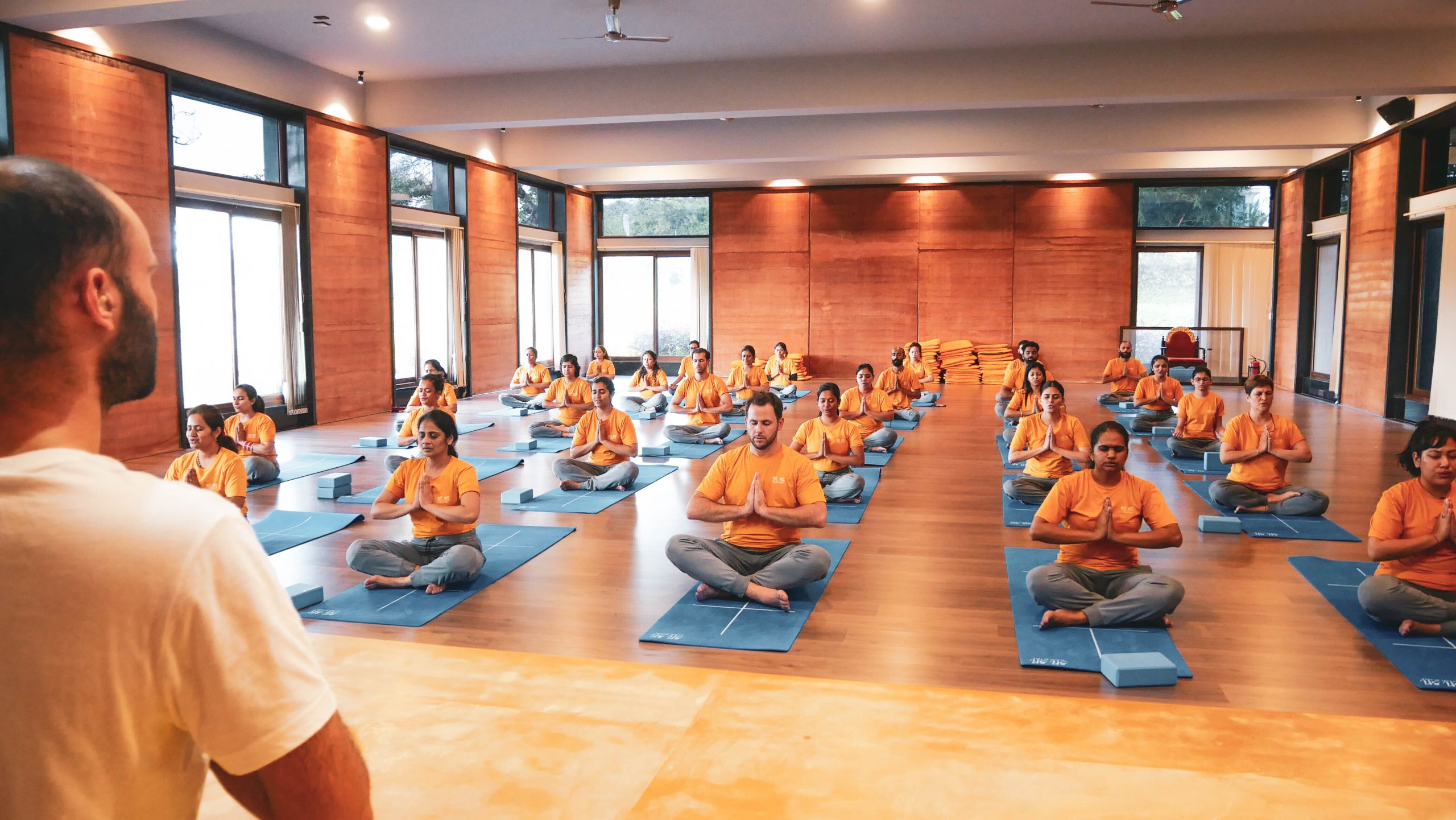
Become a registered yoga teacher
200h yoga teacher training.
Online: May 27 - Jun 30, In-Person: Jul 7 - Jul 14
FAQ’s about Bhujangasana
You may like:.
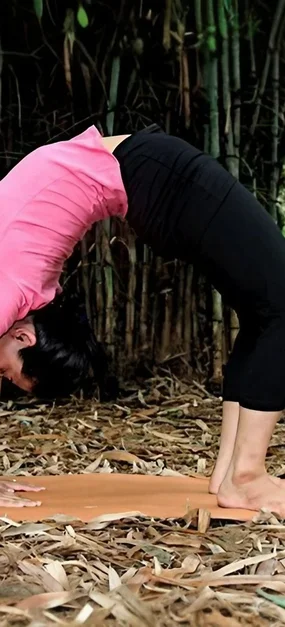
Chakrasana (Wheel Pose or Urdhva Dhanurasana)
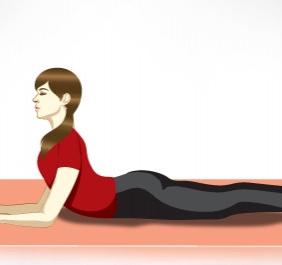
Salamba Bhujangasana (Sphinx Pose)
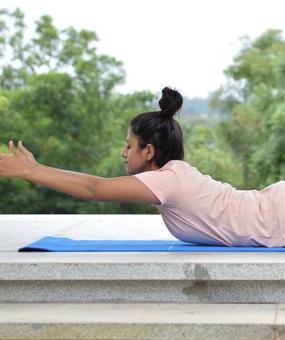
Viparita Salabhasana (Superman Pose)
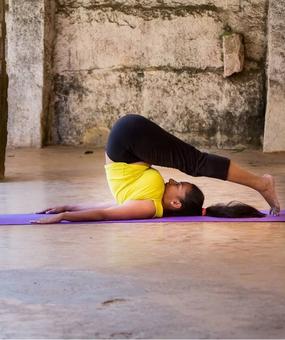
Halasana (Plow-Pose)
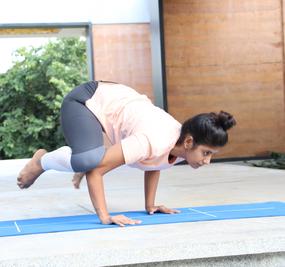
22 popular animal yoga poses
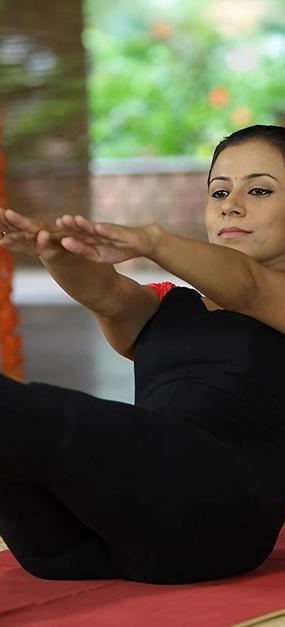
12 Difficult Yoga Poses to Challenge Yourself

Beginner (in person)

Beginner (online)

Children and Teens

4 Yoga Poses for better posture!

Project On Yoga Physical Education For Class 9
Table of Contents
Acknowledgement
I want to extend my heartfelt appreciation to [Teacher’s Name], our dedicated physical education instructor, for being a guiding force throughout the creation of this project. The wisdom and encouragement shared have played a crucial role in molding both the content and framework. I also want to express my gratitude to [Name of Friends or Classmates] for their collaborative spirit and uplifting support during the project’s culmination
Introduction
Yoga, an ancient discipline rooted in Indian philosophy, has garnered widespread acclaim for its holistic approach to fostering physical and mental well-being. In the realm of physical education for class 9 students, the infusion of yoga presents a golden opportunity to elevate overall health, fitness, and cognitive functions. This undertaking delves into the myriad advantages of introducing yoga into the physical education curriculum, underscoring its relevance and profound significance.
This endeavor seeks to illuminate the objectives behind incorporating yoga into the physical education regimen for class 9 students. Through an exploration of goals and anticipated outcomes, it endeavors to emphasize the intrinsic value of integrating yoga as a pivotal element of the educational journey. This integration is poised to contribute not only to physical health but also to the mental and emotional well-being of students.
- Theoretical Underpinnings of Yoga : At the core of yoga lies the Ashtanga Yoga, or Eight Limbs of Yoga, encompassing Yamas (ethical standards), Niyamas (self-discipline), Asanas (physical postures), Pranayama (breath control), Pratyahara (withdrawal of senses), Dharana (concentration), Dhyana (meditation), and Samadhi (state of bliss). Grasping these principles provides a theoretical foundation for understanding the physical and mental benefits associated with the practice of yoga.
- Physical Profits of Yoga: The impact of yoga on physical health is far-reaching, encompassing heightened flexibility, improved strength and endurance, refined posture, and enhanced balance and coordination. Asanas, or yoga poses, strategically engage various muscle groups, promoting overall fitness and contributing to injury prevention. Examining these physical benefits sheds light on how yoga seamlessly complements conventional physical education activities for class 9 students.
- Mental and Emotional Gains of Yoga: Beyond the corporeal realm, yoga exerts a substantial influence on mental and emotional well-being. Regular practice has been correlated with stress reduction, heightened focus, and augmented self-awareness. By integrating yoga into the physical education curriculum, students can cultivate tools for stress management and emotional resilience, fostering a positive and enriching learning experience.
- Yoga in the Physical Education Curriculum: This segment delves into the pragmatic integration of yoga into the existing physical education curriculum for class 9 students. Sample lesson plans and activities illustrate how yoga can be seamlessly woven into the educational fabric, providing students with both theoretical knowledge and hands-on experience in various facets of yoga
Theoretical Foundation
Exploring the core principles of Ashtanga Yoga, known as the Eight Limbs of Yoga, provides a solid theoretical foundation. Understanding ethical standards, self-discipline, physical postures, breath control, withdrawal of senses, concentration, meditation, and the state of bliss sets the stage for comprehending the holistic nature of yoga.
- Physical Benefits: The project thoroughly examines the extensive impact of yoga on physical health, including increased flexibility, improved strength, enhanced posture, and better balance. By focusing on the specific yoga poses designed to engage various muscle groups, it emphasizes how yoga can complement traditional physical education activities for class 9 students.
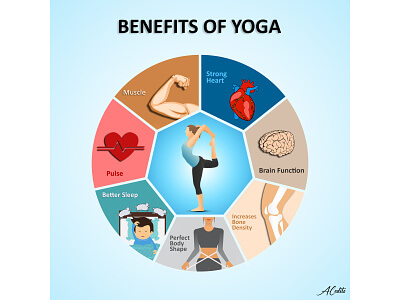
Mental and Emotional Benefits
Beyond the physical realm, the project explores the mental and emotional benefits of yoga, linking its regular practice to stress reduction, heightened focus, and increased self-awareness. The incorporation of yoga into the physical education curriculum is presented as a means for students to develop tools for managing stress and cultivating emotional resilience.
- Practical Integration: A key highlight of the project lies in its practical approach to integrating yoga into the existing curriculum. Sample lesson plans and activities provide tangible examples of how yoga can seamlessly weave into the educational fabric, offering students both theoretical knowledge and hands-on experience in various facets of yoga.
In summary, this project has meticulously explored the diverse benefits of incorporating yoga into the physical education curriculum tailored for class 9 students. By investigating the theoretical underpinnings of yoga and conducting a thorough analysis of its physical, mental, and emotional advantages, it is evident that yoga stands as a valuable enhancement to the educational journey. The practical integration of yoga into the existing curriculum, as exemplified in the provided sample lesson plans, underscores its feasibility and potential positive impact on the overall well-being of students. Embracing and acknowledging yoga’s holistic approach sets the stage for a more comprehensive and enriching physical education program.
Bibliography
- Iyengar, B. K. S. “Light on Yoga.” HarperCollins, 1979.
- Kaminoff, Leslie, and Matthews, Amy. “Yoga Anatomy.” Human Kinetics, 2011.
- Desikachar, T. K. V. “The Heart of Yoga: Developing a Personal Practice.” Inner Traditions, 1995.
- Field, Tiffany. “Yoga Clinical Research Review.” Complementary Therapies in Clinical Practice, vol. 24, 2016, pp. 145-161.
- Sengupta, Pallav, et al. “Effect of Yoga-Based Physical Activity on Pain, Mobility, and Gait Speed in Chronic Low Back Pain: A Randomized Controlled Study.” Journal of Complementary and Integrative Medicine, vol. 15, no. 1, 2018.
Certificate of Completion
This is to certify that I, [Student’s Name], a [Class/Grade Level] student, have successfully completed the “project on yoga physical education for class 9.” The project explores the fundamental principles and key aspects of the chosen topic, providing a comprehensive understanding of its significance and implications.
In this project, I delved into in-depth research and analysis, investigating various facets and relevant theories related to the chosen topic. I demonstrated dedication, diligence, and a high level of sincerity throughout the project’s completion.
Key Achievements:
Thoroughly researched and analyzed “project on yoga physical education for class 9.” Examined the historical background and evolution of the subject matter. Explored the contributions of notable figures in the field. Investigated the key theories and principles associated with the topic. Discussed practical applications and real-world implications. Considered critical viewpoints and alternative theories, fostering a well-rounded understanding. This project has significantly enhanced my knowledge and critical thinking skills in the chosen field of study. It reflects my commitment to academic excellence and the pursuit of knowledge.
In order to download the PDF, You must follow on Youtube. Once done, Click on Submit
Subscribed? Click on Confirm
Download Project On Yoga Physical Education For Class 9 PDF
Related articles.

Areas Of Home Science for class 12th CBSE
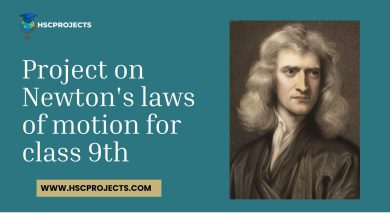
Project on Newton’s laws of Motion for Class 9th
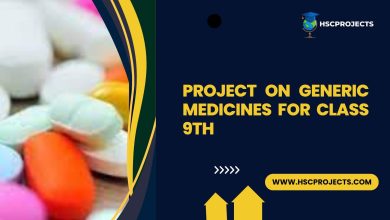
Project on Generic Medicines For Class 9th

Principle Of Management Project On Cloth Shop For Class 12
Leave a reply cancel reply.
Your email address will not be published. Required fields are marked *
Notify me of follow-up comments by email.

Please Enable JavaScript in your Browser to Visit this Site.
Academia.edu no longer supports Internet Explorer.
To browse Academia.edu and the wider internet faster and more securely, please take a few seconds to upgrade your browser .
Enter the email address you signed up with and we'll email you a reset link.
- We're Hiring!
- Help Center

Yoga and Physical Education: Swami Kuvalayananda’s Nationalist Project. Asian Medicine: Tradition and Modernity 3: 20 – 36

Related Papers
Joseph S Alter
Volume 4 (2023): Special Issue of the Journal of Yoga Studies.Yoga and the Traditional Physical Practices of South Asia: Influence, Entanglement and Confrontation
Daniela Bevilacqua
This volume is the outcome of a workshop held at SOAS University of London in November 2019, under the auspices of the five-year, ERC-funded Haṭha Yoga Project (HYP). The workshop was organised because of several questions that had been on our minds for some time: considering the centuries-long presence of multiple embodied traditions in India, what was the relationship between the physical practices of yoga and other physical disciplines that bear certain similarities to yoga, at least in appearance? Had there been interchange or even influence across and between different physical disciplines and the practices of yoga? Could such a perspective on the history of yoga help to understand better any of its developments?
Stuart Ray Sarbacker
Clear, accessible, and meticulously annotated, _Tracing the Path of Yoga_ offers a comprehensive survey of the history and philosophy of yoga that will be invaluable to both specialists and to nonspecialists seeking a deeper understanding of this fascinating subject. Stuart Ray Sarbacker argues that yoga can be understood first and foremost as a discipline of mind and body that is represented in its narrative and philosophical literature as resulting in both numinous and cessative accomplishments that correspond, respectively, to the attainment of this-worldly power and otherworldly liberation. Sarbacker demonstrates how the yogic quest for perfection as such is situated within the concrete realities of human life, intersecting with issues of politics, economics, class, gender, and sexuality, as well as reflecting larger Indic religious and philosophical ideals.
Philosophy East and West, vol. 55, no. 2
Marzenna Jakubczak
International Journal of Yoga Therapy
Laura Douglass
Scripta Ethnologica
Gabriel Martino
In this paper we develop a contrastive analysis of some aspects of Modern and Classical yoga. With this purpose we first provide a brief discussion of what has been labelled ‘modern postural yoga,’ addressing the transformation that, according to specialists, yoga has undergone in the last century and a half. This process, scholars argue, led to an emphasis in postural exercise and health, and located the focus of the practice on the body. We then analyse, in the second part of the work, Patañjali’s Yogasūtras, its relation to āyurvedic ancient literature, and concentrate our attention on the elements related to health, the body, and the physical activity we will propose are present in Patañjali’s treatise. In the third part, we discuss the respects in which the contemporary transnational yoga phenomenon represents a continuation of the ancient tradition of which Patañjali’s text is an expression. This contrastive analysis provides us an excellent opportunity to examine aspects of the classical yoga treatise that have yet to play a significant role in the discussion regarding the relationship between Modern and Classical yoga.
Lloyd Pflueger
Religions of South Asia
Patrick S D McCartney
Eric John Shaw
Bellur Krishnamachar Sundararaja Iyengar (1918 - 2014) is arguably the most influential teacher in all of yoga history. The myth of his life was shaped by an intimate tie to an equally legendary figure, his brother-in-law and guru, Sri Tirumalai Krishnamacharya (1888 - 1989). Iyengar has been given some attention in scholarly circles, most notably by Elizabeth De Michelis in her History of Modern Yoga (2004) and, tangentially, in Mark Singleton's Yoga Body: The Origins of Modern Posture Practice (2010). This essay uses De Michelis and Singleton's investigations as jumping off points, thoroughly examining Iyengar's biography to reveal the difficult range of experiences he had with his guru. It offers a psychological assessment of the consequences of those episodes and follows their expression in Iyengar's pedagogy, persona, and in the culture of his students. For researchers curious about Iyengar's praxis and its growth, this essay further explores the adoption of the Yoga Sutras as the fallback descriptor of his method. It situates Iyengar's work within hermeneutic patterns found elsewhere in the Modern Yoga project, even as it diverges from the operative conclusion of De Michelis, i.e. that Iyengar utilized memes offered by occult philosophies to take his teaching into modern alt-culture forums.
RELATED PAPERS
Maria Musiol
Victoria Garcia Esteve
Bulletin of Entomological Research
glen powell
Andrei Ionas
POLÍTICAS SOCIAIS: acompanhamento e análise
Luiz Parreiras
Bioorganic & Medicinal Chemistry
CHANDRAKANT TRIPATHI (RA2011053010028)
Zer Revista De Estudios De Comunicacion Komunikazio Ikasketen Aldizkaria
ELIAS RANGEL CARVALHO MACHADO
IEEE Journal of Microwaves
Mahmoud Wagih
Sticky Feet: How Labor Market Frictions Shape the Impact of International Trade on Jobs and Wages
diego rojas rojas
La Revue de Médecine Interne
robin dhote
Journal of Health and Care
TAHEREH ashketorab
Galuh Yuliani
Physica B: Condensed Matter
Abdul Hannan
Edgar Limón soto
GHANCARAN: Jurnal Pendidikan Bahasa dan Sastra Indonesia
Dona Aji Karunia Putra
Phelipe Alves
Peter Varley
Karla Elizabeth Estrada Contreras
Roy Cabonegro
Finance Research Letters
Dimitris Kenourgios
Abdulkadir Usman
Usman Abdulkadir
Nazmi Misini
Melanoma research
Anna M. Czarnecka
Forest Ecology and Management
Markku Kanninen
Fabio Pinelli
See More Documents Like This
RELATED TOPICS
- We're Hiring!
- Help Center
- Find new research papers in:
- Health Sciences
- Earth Sciences
- Cognitive Science
- Mathematics
- Computer Science
- Academia ©2024
Yoga | Class 11 Chapter 3 Notes 2023
Meaning and importance of yoga.
The term Yoga comes from the Sanskrit word ‘Yuj’, meaning ‘union’ or ‘to join’. It is the union of Atma (soul) and Paramatma (super controller).
Yoga brings physical harmony and mental balance. It is the combination of physical asanas, meditation, and breathing techniques to strengthen the muscles and relieve from stress.
The main purpose of Yoga is to provide a sound body and a sound mind. The aim of Yoga is ‘self-identification’ and ‘self-perfection’ which comes through ‘self-purification and self-realization’.
- Yoga improves the efficiency of the cardiovascular system
- Organs get strengthened
- It prevents premature ageing
- It helps to maintain good posture
- Yoga Improves brain function
- It lowers stress levels
- Yoga increases flexibility
- Yoga lowers blood pressure
- Gives relieve from stress and anxiety
- It can gives relieves from chronic back pain
- It lowers blood sugar level
- It improves the sense of balance
- It makes the bones stronger
- Helps to maintain a healthy weight
- Lowers risk of many diseases
Introduction To Ashtanga Yoga
Elements of Yoga
In Patanjali’s Yoga Sutras, the eightfold path is called ashtanga, which literally means “eight limbs (ashta = eight, anga = limb). These eight steps are a guideline on how to live a good life.
The focus is on moral and ethical conduct and self-discipline. These are designed to improve health and benefit in spiritual areas of our lives.
The first four stages of Patanjali’s ashtanga Yoga concentrate on refining our personalities, gaining mastery over the body and developing an energetic awareness of ourselves, to prepare for the second half of this process which deals with the senses, the mind and attaining a higher state of consciousness.

Eight Elements of Yoga
Eight elements to attain highest purification of body and mind are as follow:
Yama (abstinence)
There are many morality guidelines for good behaviour in society, which must be followed by everyone. These elements the basic principles for the benefits of society.
These principles are:
- Ahimsa (Non-Harming)
- Satya (Truthfulness )
- Asteya ( Non-Stealing )
- Brahmacharya (Moderating the Senses )
- Aparigraha (Non-Possessiveness )
Niyam (observances)
Niyam are personal observances or self-purification by discipline. It makes the individual healthy.
- Saucha (Cleanliness)
- Santosh (Contentment)
- Tapa (Austerity)
- Swadhyaya (Study of good literature)
- Ishwar Paridhana (Surrender to God)
Asanas (yoga postures)
Asanas are slow stretching activities performed to improve the whole body fitness. It can be done in all three positions viz. Standing, sitting and lying.
Pranayama (breathing control)
Pranayama is a systematic and rhythmic control of breathing, performed to improve the internal functioning of the whole body.
Pranayam is based upon Purak (Inhale) Rechak (Exhale) and Kumbhak (holding breath)
Pratyahara (withdrawal of the senses)
Pratyahara is conscious withdrawal of energy from the senses. It is performed to improve intellectual capability. It develops inner mental strength by controlling sense organs
Dharana (concentration)
Dharana is fixing the attention on a single object for a long time to improve concentration. This mental fixation should be uninterrupted and without any kind of mental activities.
Dhayana (meditation)
Dhayana is the process of controlling the mind through meditation. It develops a high level of concentration.
Samadhi (absorption)
Samadhi is the state of super-consciousness where dhayana reaches its final stage. It is also the state of union with God, merging consciousness and salvation

Yogic Kriya s (Shat Karma)
Yogic Kriyas are cleansing techniques that cleanse various internal organs of the body. They are also called shat kriyas or shatkarmas because they are six in number.
Shuddhi Kriya (Shatkanna): Shatkarmas cleanse and activate all vital organs of the body especially the digestive, respiratory, circulatory and nervous systems.
They are preventive as well as curative in nature. One’s capacity to digest, taste, work, think and feel gets enhanced. These kriyas are done to prepare the body for Yoga practice such as asanas, pranayama and meditation by eliminating physical distractions, discomfort and fatigue.

There are six major cleaning processes in Yoga:
1. Kapalbhati
2. Neti (upper nasal track)
3. Trataka (eye exercises)
4. Nauli (abdominal muscle and viscera)
5. Dhouti (cleansing the intestine)
6. Vasti (cleaning of the rectum)
Click Below To Learn Other Chapter Notes
- Class 11 Physical Education Syllabu s
- Chapter 1: Changing Trend and Career Option
- Chapter 2: Olympic value education
- Chapter 3: Yoga
- Chapter 4: Physical Education and sports for CWSN
- Chapter 5: Physical Fitness, Wellness
- Chapter 6: Test Measurement And Evaluation
- Chapter 7: Fundamentals of Anatomy, Physiology In Sports
- Chapter 8: Fundamentals of Kinesiology and Biomechanics in Sports
- Chapter 9: Psychology in Sports
- Chapter 10: Training And Doping In Sports
It is designed to stimulate the brain cells and purify the brain. ‘Kapalbhati’ comes from the word ‘Kapal’ (forehead) and ‘Bhati’ which means ‘to shiné’.
- Sit in any meditative posture.
- Close the eyes and relax the whole body.
- Inhale deeply through both nostrils, expand the chest.
- Exhale breath with forceful contractions of the abdominal muscles and relax.
- Continue active/forceful exhalation and passive inhalation.
- Kapalbhati generates heat in the body, dissolving toxins and other waste matter.
- It improves the functioning of the kidneys and liver.
- It removes stress from the eyes and erases dark circles.
- It enhances blood circulation and digestion.
- It increases metabolic rate, thus aiding weight loss.
- It stimulates abdominal organs and is thus helpful for diabetic patients.
- It rejuvenates the brain and energizes nerves.
- The process has a calming effect and uplifts the mind.
- It gives a sense of balance and sensibility, makes one feel pure and clutter-free.
- It eliminates acidity and gas-related problems. Kapalbhati strengthens the lungs.
- It improves memory and concentration.
- It clears and activates the chakras in the body.
- It helps in curing asthma, sinus and hair loss.
- It keeps depression at bay and fills one with positivity.
Neti Kriyas
Neti Kriya is a type of Yogic nasal-cleansing exercise. Neti Kriya is designed to purify the nasal passages and bathe the sinuses.
They are said to remove toxins and anything blocking the flow of prana or energy in the body. Neti is a Sanskrit term derived from the roots na and ti, which together translate as “not so”.
Types of Neti
Jala neti , which is practiced using a neti pot filled with saline solution to cleanse the nasal passages. In this technique, the head is tilted to the side and then salt water is poured into a nostril and exits through the other nostril.
Sutra neti , a thread is passed through the nostrils and out of the mouth. The yogi then holds both ends of the string, pulling it back and forth to cleanse the nose. The thread should be rolled cotton and is often dipped in beeswax for easier threading.
A soft rubber catheter may also be used. Sutra neti is said to be a more effective cleansing technique than jala neti.
Dugdha neti is similar to jala neti in which a neti pot is used to cleanse the nasal passageways with warm saline solution, except that warm milk is used instead.
Ghrita neti is similar to jala neti in which a neti pot is filled with warm ghee instead. It is done using a neti pot, or a few drops of warm ghee can simply be sniffed into each nostril at a time to coat and line the nasal passageways.
Trataka, a technique used in a meditation practice, is one of the six purification techniques, called shatkarmas, of Hatha Yoga.
Trataka is a Sanskrit word, which means ‘to look’ or ‘to gaze,’ As such’ this meditation technique involves staring at a single point of focus.
This is typically the flame of a candle, but other objects that may be used include a dot on the wall, an object of worship, a deity, flower, mountain, the rising sun or moon. However, a flame is believed to work better.
Meditating in this way is believed to energize the (third eye) chakra, which is associated with intuition and wisdom, as well as psychic abilities.
- Light a candle and sit at least one metre away from it with the flame at eye level.
- Focus the gaze on the flame and keep it there without blinking for as long as possible.
- As thoughts arise, acknowledge them, then ret-um to focus on the flame.
- When the eyes start to water and tears flow, close the eyes and focus on the after-glow of the flame, bnnging awareness to the third eye point.
- Meditate here until ready to come out of the practice.
Trataka is said to be most effective when practiced consistently at sunrise or midday. Its effects can be enhanced.
Benefits of trataka include :
• Strengthens eye muscles
• Purifies the eyes
• Treats eye disorders
• Relieves insomnia
• Aids in treating depression oves concentration
• Calms the mind
• Promotes emotional stability
• Boosts willpower
• Develops intuition and clairvoyance
Nauli is one of the Shatkarmas in Yogic Kriyas, which is an integral part of Hatha Yoga. This kriya uses the abdominal muscles to massage the organs in the abdomen and stomach region.
It has Immense health benefits, but is not easy to do, especially at the beginning. This is an exercise that Involves a rolling movement of the abdominal muscles.
Nauli kriya is typically practiced on an empty stomach and from a standing position. Nauli kriya begins with a complete breath out, then the abdomen is brought in, contracting the central muscles
Nauli kriya is thought to relieve constipation and digestive issues. Those who suffer from heart disease, high blood pressure, hernia, ulcers or gastrointestinal problems should not practise this
The best time to practise is early morning after bowel movement.
1. First stand with your legs apart and then bend the knees. While bending the knees, use the
2. Exhale forcefully making a hissing sound, just like in Kapalbhati.
3. Try to contract the belly inward and then upward. This is the base position for performing Nauli
4. Stop the breath and isolate the abdominal muscles (Left rectus muscles for vama Nauli, right ones for Dakshina Nauli and middle ones for Madhya Nauli).
5. Then fry and hold the position for a few seconds.
6. Breathe in and release the kriya pose. Come back to a comfortable standing position.
- Massage of internal organs keeps them healthy.
- Strengthens stomach muscles and helps improve digestion capability.
- Strengthens functioning of vital organs.
This is for purification of the esophagus and stomach. This technique is also known as Gaj Karn. Gaj means elephant. When an elephant experiences nausea’ it reaches its trunk deep into its gullet
Dhouti is a method of washing up of the entire tract starting from the mouth to the digestive path at the beginning of the small intestines, that is the mouth’ stomach. etc.
One can wash one’s mouth, but in the daily routine one cannot wash the Esophagus or the stomach. The impurities residing there are carried along with the food particles and are mixed in some proportion with the blood.
There are two kinds:
i. Jala Dhauti or Kunjala Kriya
Procedure :
Mix two liters of warm water (40°) with 1 teaspoon of salt. Stand upright and drink the water rapidly glass by glass. Bend forward slightly, press the left hand into the lower abdomen and extend the index and middle fingers of the right hand partially down the throat.
Simultaneously, press the tongue down so that nausea is induced. The entire quantity of the water comes out again in half a minute.
This can be repeated once or twice each week and is best performed in the morning on an empty stomach.
Has a beneficial influence on high acidity, allergies and asthma. Eliminates halitosis (bad breath).
Do not practice this exercise with high blood pressure or glaucoma.
ii. Vastra Dhauti
Procedure :
This stomach purification technique requires the use of a strip of cotton, 3 meters in length and 10 centimeters wide. First-time practice of this technique must be performed only with the guidance of a “Yoga in Daily Life” teacher.
Like Dhauti this technique purifies the stomach and helps relieve high acidity. It purifies the upper respiratory tract, and thereby eases asthma, and dust and pollen allergies.
Medicated oil or ghee and herbal decoction is given as enema to clean the colon and increase the muscle tone. After this, the previously-lubricated nozzle is pushed into the rectum for about 4 to 6 inches so as to make the oil or decoction enter and move through the colon.
The general idea is to clean from inside. Ayurveda has favored this method of treatment for various disorders.

Pranayama And Its Type s
It is the fourth stage of Yoga. Pranayam is systematic breathing activities in which inhalation (purak), exhalation (rechak) holding of breath (kumbhak) are controlled.
This systematic rhythmic control of breathing provides deep effects over an individual health. It develops inner strength and cure’s many health ailments.
Anulom-Vilom Pranayam
It is an alternate breathing technique. In this process close your right nostril with the thumb, breathe in from left nostril, than close left nostril and breathe out from right nostril. Repeat from another side.
Kapalbhati Pranayam
In Kapalbhati pranayam forceful exhalation is performed where inhalation happens automatically. Exhalation is done from the nose with pressure while the stomach is vibrated in and out.
Bhramari Pranayama
In this pranayama, exhalation is done with humming sound from the throat with closed ears with thumbs.
Sitli Pranayam
It is a forceful exhalation from the mouth with the tongue rolled. It provides a cold feeling to the body.
Active Lifestyle and Stress Management through Yoga
Living an active lifestyle and effectively managing stress are essential aspects of maintaining overall well-being. Yoga, an ancient practice that originated in India, offers a holistic approach to achieving both physical and mental balance. In this note, we’ll explore the benefits of incorporating yoga into your daily routine for an active and stress-free life.
Active Lifestyle:
An active lifestyle involves engaging in regular physical activities that keep your body in motion. Whether it’s walking, jogging, cycling, or participating in sports, staying active promotes cardiovascular health, strengthens muscles, and improves flexibility.
By including yoga in your routine, you can enhance your overall physical fitness as it combines various postures, stretches, and breathing exercises that target different muscle groups.
Stress Management :
In today’s fast-paced world, stress has become a common factor that affects our mental and emotional well-being. Managing stress is crucial for maintaining a healthy life.
Yoga provides an effective means of stress relief through its focus on mindfulness and relaxation techniques. By practicing yoga regularly, you can learn to be present in the moment, let go of worries, and reduce anxiety.
Mind-Body Connection :
Yoga emphasizes the mind-body connection, acknowledging that our mental state significantly influences our physical health and vice versa.
By practicing yoga, you can cultivate self-awareness, develop a positive outlook, and learn to listen to your body’s needs. This awareness can guide you to make healthier lifestyle choices, leading to improved overall wellness.
Breathing Techniques :
One of the fundamental aspects of yoga is its emphasis on breath control. Deep breathing exercises, also known as pranayama, help calm the mind and reduce stress.
By incorporating these techniques into your daily routine, you can enhance your ability to cope with stressful situations and improve your emotional resilience.
Flexibility and Strength:
Yoga postures, or asanas, involve a combination of stretching and strengthening exercises. Regular practice can increase your flexibility, making your body more agile and less prone to injuries.
Moreover, some yoga poses require significant muscle engagement, leading to improved strength and endurance over time.
Better Sleep:
Sleep is essential for the body’s recovery and rejuvenation. However, stress and a sedentary lifestyle can negatively impact sleep quality.
Practicing yoga before bedtime can help you relax, release tension, and promote better sleep patterns, allowing you to wake up feeling refreshed and energized.
Asanas are performed in standing, sitting and lying (supine and prone) position. The warming up in Yoga is performed with Surya Namaskar.
Asanas are the third step of yoga in which slow stretching activities are performed, by holding body postures which brings stability of body and poised mind.
Meditation is a process which controls the mind and its activitie. It is a very powerful process as it stabilises the mind in a proper direction.
In meditation, we focus our mind on a particular object, thought, or activity and pay attention to the breath.
Yoga For Concentration

It is a simple sitting posture with crossed legs, hands over the knee and back straight
Benefits :
- Improves concentration
- Improves leg Strength
- Cures Arthritis, and Knock Knee
It is a standing posture on toes, arms straight up and joined palms.
- Develop leg muscles
- Increase height in children
- Relieve ankle and leg pain
It is a sitting posture with crossed legs, feets touching opposite hips, hands on the knees and back straight.
- Improve concentration
- Improve leg strength
- Cures Arthritis, Sciatica and Knock Knee
Shashank Asana
Sit in the kneeling position while keeping the hips on the heels, toes pointing outside and big toes should touch each other at the back. Bend body at the front while hands and head touches the floor at the front.
- Improves leg strength and flexibility.
- Cures Arthritis, Knock Knee
Lie down flat, lift your chest and feet off the ground upto 10 inches, stretch your arms towards feet. Feel the tension in your stomach area, the weight of your body on the buttocks.
- It strengthens the arms, thighs and shoulders, neck muscles.
- It improves the function of organs
- It helps in regulating blood flow
Vriksh asana
Stand straight, feets together, bend your right knee, place your right sole on your left thigh, gently raise your arms over your head and bring them together. Look straight
- It strengthens the spine
- It improves neuromuscular coordination.
- It tones the leg muscles
- It strengthens the knees
Garud Asana
Stand straight, bend your right knee and left foot cross over the right knee. Cross the right arm over the left arm and bend your elbows, palms facing each other
- It stretches the thighs, shoulders and upper back.
- It improves balance.
- Strengthens the calves.
- Makes the hip flexible
Relaxation Techniques for improving concentration
Yog Nidra is a relaxation techniques for relaxing body and improving concentration.
Procedure
- Lie down straight on your back
- Close your eyes.
- Take a few relaxed and slow deep breaths
- Take your attention to your right foot for a few seconds, while relaxing your foot.
- Next move your attention to the right knee, right thigh and hip.
- Repeat this same process for the left leg.
- Take your attention to all parts of the upper body: stomach, navel region, chest.
- Now take attention to the right shoulder, right arm, palms, and fingers.
- Repeat this same process on the left shoulder, left arm
- Finally throat, face, and top of the head.
- Now take a deep breath and observe the sensations in your body.
- Relax in this state for a few minutes.
- Slowly sit up and open your eyes.
- It improves concentration
- It cools down the body after yoga postures
- It activates the nervous system to absorb the effects of yoga asanas
Frequently Asked Questions
Q1. What are elements of Yoga?
Answer: Yoga has eight elements to attain purification of body and mind to achieve the union of Atma and Paramatma. Yama, Niyam, Asana, Pranayam, Pratyahara, Darana, Dyan and Samadhi
Q2. What is the main purpose of Yoga?
Answer : The main purpose of Yoga is to provide a sound body and a sound mind. The aim of Yoga is ‘self-identification’ and ‘self-perfection’ which comes through ‘self-purification and self-realization’.
Q3. What is Astanga Yoga?
Ans . In Patanjali’s Yoga Sutras, the eightfold path is called ashtanga, which literally means “eight limbs (ashta = eight, anga = limb). These eight steps are a guideline on how to live a good life.
Q4. What do you mean by Kriyas?
Ans . Yogic Kriyas are cleansing techniques that cleanse various internal organs of the body. They are also called shat kriyas or shatkarmas because they are six in number.
Yoga chapter 5 CBSE, class 11 Physical Education notes. This cbse Physical Education class 11 notes has a brief explanation of every topic that NCERT syllabus has.
You will also get ncert solutions, cbse class 11 Physical Education sample paper, cbse Physical Education class 11 previous year paper.

Final Words
From the above article you must have learnt about ncert cbse class 11 Physical Education notes of chapter 3 Yoga. We hope that this crisp and latest Physical Education class 11 notes will definitely help you in your exam.

IMAGES
VIDEO
COMMENTS
1. According to Patanjali, yoga means to control the desires of a human being. 2. The system of yoga is built on the three main structures: exercise, breathing and meditation. 3. The practices of yoga are designed to put pressure on the glandular systems of the body, increase its efficiency and total health.
Incorporating yoga in my physical education curriculum has enhanced my ability to teach students about flexibility, stress management, and mindfulness. ... I place multiple yoga poses at a station by rainbow color theme. Blue cone and blue cards = balance poses. ... Project-based: Design-your-own workout, student presentations, etc. Closure ...
Adding yoga to physical education is an excellent way for students to learn about and experience the various benefits of yoga and mindfulness. Yoga movements and poses can help students learn about their bodies and understand how to move with proper alignment and posture, as well as improve strength, flexibility and balance. It also has the added benefit of helping students focus and ...
Class XII Physical Education . 2 . Benefits of Asanas for Prevention of Diseases . a) Bones and joints become strong: By performing regular asana, the bones, cartilages, and ligaments become strong. Along with this, height of children is enhanced. b) Circulation of blood becomes normal: By performing asana regularly, the
Asana is a Sanskrit word meaning "posture," "seat," or "place.". Asanas are the physical positions we assume during a hatha yoga practice. Each pose has its own Sanskrit and English name. Almost all of the Sanskrit names for the poses end with "asana.". For example, the classic lotus pose is named Padmasana, and the common tree ...
YOGA CLASS 12 IVESTIGATORY PROJEST - Free download as Word Doc (.doc / .docx), PDF File (.pdf), Text File (.txt) or read online for free. This project is for class 12 physical education investigatory project, on the topic yoga
Make sure you perform this asana 4-5 hours after having your main meal. This will ensure that you are not uncomfortable lying on your stomach. Ensure that you have done some basic warm-up and stretching exercises to loosen your arms, shoulders, neck, and back. It is always best to practice yoga asanas in the morning. However, if you are unable ...
Physical Benefits: The project thoroughly examines the extensive impact of yoga on physical health, including increased flexibility, improved strength, enhanced posture, and better balance. By focusing on the specific yoga poses designed to engage various muscle groups, it emphasizes how yoga can complement traditional physical education ...
Among all its techniques the physical postures, called asanas in Sanskrit, are the ones that got. It is necessary to remember that sports and gymnastics belong to the scope of Physical Education. Once there was a time when people said "it is not the winning itself but the competing nobly that really matters", when the place
Here is a Physical Education Class 11 Practical file , relating to the Yogas and Asanas , relating to the Physical Ailments and Diseases - Asthma, Obesity ...
In short he is able to ensure perfect health for his mind.20 Although this resonates with many statements in Tom Brown's School Days, yoga physical education reverses the direction of causality by defining moral conduct and a lifestyle of self-discipline as prerequisites for, rather than the derived benefit of, physical development.21 ...
yoga project class 12 cbse - Free download as Word Doc (.doc / .docx), PDF File (.pdf), Text File (.txt) or read online for free. this is yoga project for class 12 cbse of physical education it contains 10 asanas
This is a Physical Education File Class 12 on Yoga Asanas as per CBSE Guidelines.Also Watch - Physical Education Project Class 12 on Football(Cristiano Ronal...
Strength and Yoga: Yoga increases an athlete's strength. Strengthening in yoga requires entire body to be working as a unit so that the strengthening one muscle group is connected to that of another muscle group. Yoga works on muscles that support the spine and strengthening them, gives the body more flexibility.
M eaning. The term Yoga comes from the Sanskrit word 'Yuj', meaning 'union' or 'to join'. It is the union of Atma (soul) and Paramatma (super controller). Yoga brings physical harmony and mental balance. It is the combination of physical asanas, meditation, and breathing techniques to strengthen the muscles and relieve from stress.
#class12thphysicaleducationproject#class12physicaleducationprojectonyogaandasana#simpleprojectfile-----class 12th physical edu...
An asana is a body posture that is used to improve one's health and mental well-being. Asanas lubricate the muscles, joints, ligaments, and other parts of the body. This aids in the circulation ...
Asana for class 12 Physical Education project - Free download as PDF File (.pdf) or read online for free. Print directly contains 10 poses of asana without watermark
362849876-Physical-Education-Project - Free download as Word Doc (.doc / .docx), PDF File (.pdf), Text File (.txt) or read online for free.